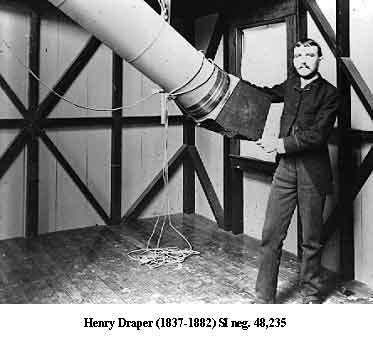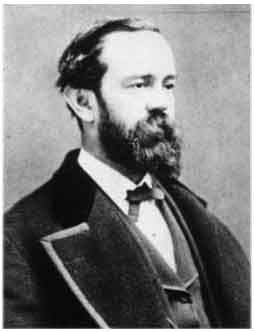|
|
Henry Draper. Henry Draper (March 7, 1837 – November 20, 1882) was an American doctor and astronomer. Henry Draper's father, John William Draper, was an accomplished doctor, chemist, botanist, and professor at New York University; he was also the first to photograph the moon through a telescope in the winter of 1839-1840.[1] Draper's mother was Antonia Coetana de Paiva Pereira Gardner, daughter of the personal physician to the Emperor of Brazil. He graduated from New York University medical school, at the age of 20, in 1857[1]. He worked first as a physician at Bellevue Hospital, and later as both a professor and dean of medicine at New York University (NYU). In 1867 he married Anna Mary Palmer, a wealthy socialite. Draper was one of the pioneers of the use of astrophotography. He took the first stellar spectrum in 1872 that showed absorption lines. He directed an expedition to photograph the 1874 transit of Venus, and was the first to photograph the Orion Nebula, on September 30, 1880 using his 11 inch Clark Brothers photographic refractor he took a 50 minute exposure.[1] For his activities he received numerous awards, including honorary law degrees from NYU and the University of Wisconsin-Madison, a Congressional medal for directing the U.S. expedition to photograph the 1874 transit of Venus, and election to both the National Academy of Sciences and the Astronomische Gesellschaft. In addition, he held memberships in the American Photographic Society, the American Philosophical Society, the American Academy of Arts and Sciences, and the American Association for the Advancement of Science.
Henry Draper. After his untimely early death from double pleurisy, his widow funded the Henry Draper Medal for outstanding contributions to astrophysics and a telescope, which was used to prepare the Henry Draper Catalog of stellar spectra. This historical Henry Draper's telescope is now in at the Toruń Centre for Astronomy (Nicolaus Copernicus University) at Piwnice in Poland. The small Draper crater on the Moon is named in his honor. References 1. ^ a b c O'Dell, C. Robert (2003). The Orion Nebula. Harvard University Press. ISBN 0-674-01183-X. Retrieved from "http://en.wikipedia.org/"
|
|
|||||||||||

